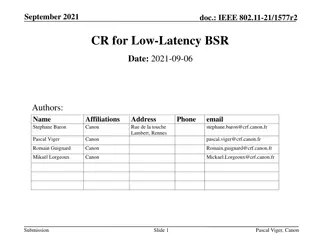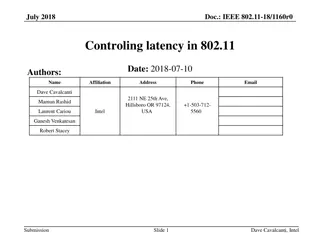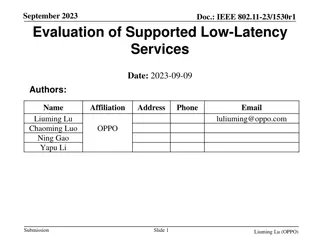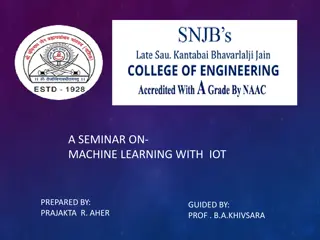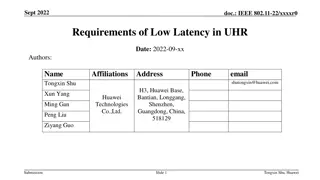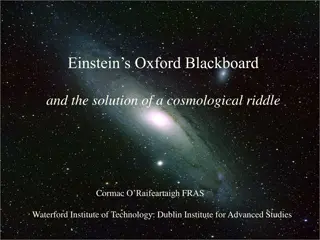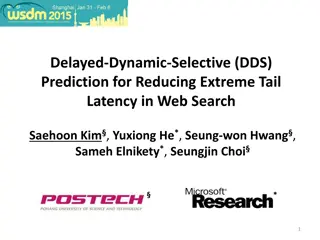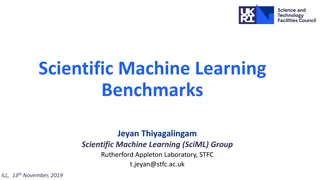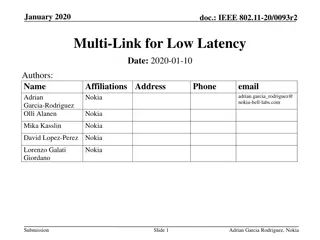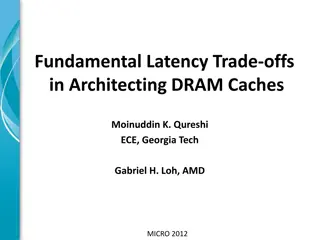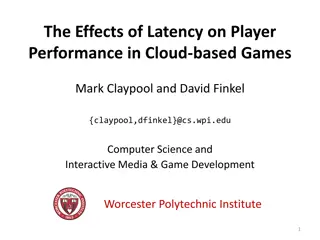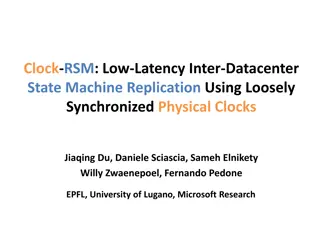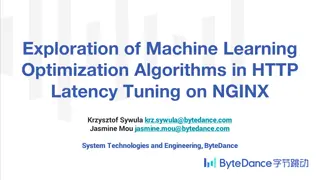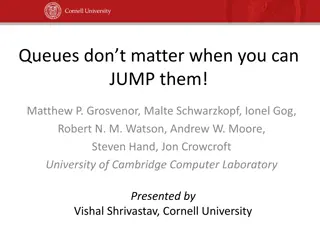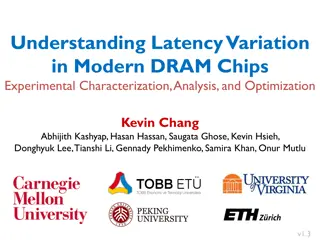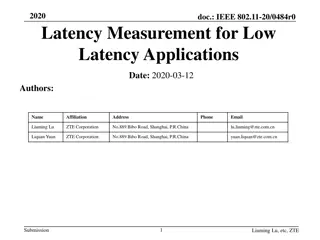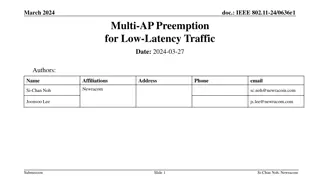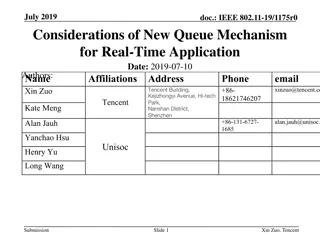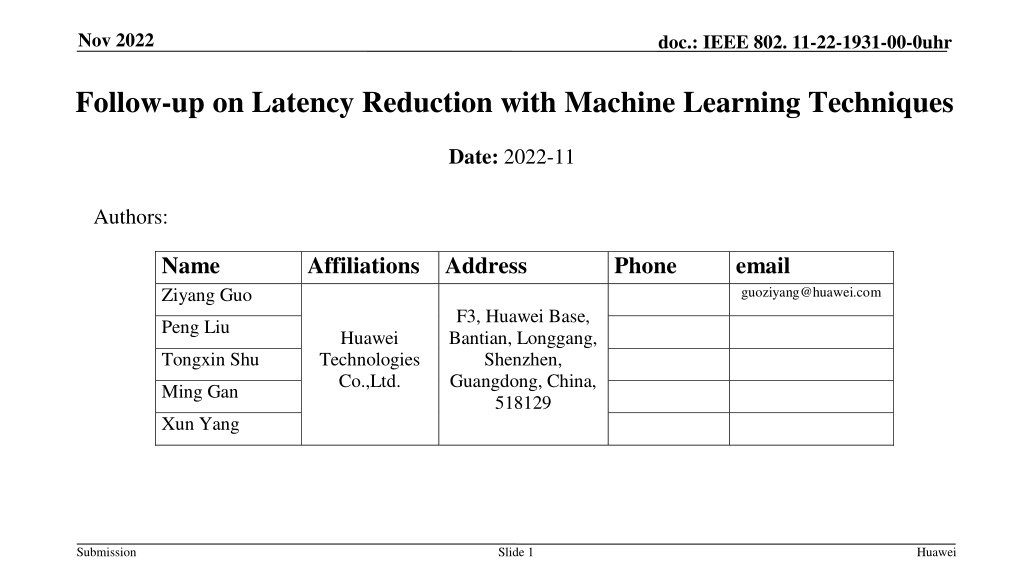
Latency Reduction with Deep Reinforcement Learning in IEEE 802.11 Networks
Explore how deep reinforcement learning techniques are utilized for latency reduction in IEEE 802.11 networks. This follow-up discussion introduces a DRL-based channel access scheme, demonstrates its efficacy in reducing latency, and discusses potential standard impacts. Details cover the basics of DRL, training and inference phases, NN model architecture, and overhead comparisons with SU-MIMO beamforming. Authors from Huawei Technologies discuss the application of DRL in improving network performance.
Download Presentation

Please find below an Image/Link to download the presentation.
The content on the website is provided AS IS for your information and personal use only. It may not be sold, licensed, or shared on other websites without obtaining consent from the author. Download presentation by click this link. If you encounter any issues during the download, it is possible that the publisher has removed the file from their server.
E N D
Presentation Transcript
Nov 2022 doc.: IEEE 802. 11-22-1931-00-0uhr Follow-up on Latency Reduction with Machine Learning Techniques Date: 2022-11 Authors: Name Ziyang Guo Affiliations Address Huawei Technologies Co.,Ltd. Phone email guoziyang@huawei.com F3, Huawei Base, Bantian, Longgang, Shenzhen, Guangdong, China, 518129 Peng Liu Tongxin Shu Ming Gan Xun Yang Submission Slide 1 Huawei
Nov 2022 doc.: IEEE 802. 11-22-1931-00-0uhr Introduction In previous UHR meetings, we discuss the latency sensitive use cases and latency reduction methods using machine learning techniques, especially distributed channel access using neural network [1]. In this contribution, we have a follow-up discussion on this topic and focus on three aspects: Introduce a deep reinforcement learning (DRL)-based channel access scheme Show the effectiveness of DRL-based channel access on latency reduction Discuss on possible standard impacts Submission Slide 2 Huawei
Nov 2022 doc.: IEEE 802. 11-22-1931-00-0uhr DRL-based Channel Access (1) Basics of DRL: DRL is a way of learning the policy that maximizes a long-term reward via interaction with the environment State: ?? ?, Action: ?? ?, Reward: ?? Long-term reward: a discounted sum of the immediate reward, i.e., ??[ ?=0 is the policy parameterized by a neural network (NN) Learn the policy means to learn the NN parameters ? ????], ? 0,1 is the discount factor, ?: ? ? A DRL-based channel access was proposed in [2], called QLBT (QMIX-advanced Listen-Before-Talk) Historical Observation Transmit or Wait Neural Network (NN) States: a sequence of historical CCA results (busy or idle), transmission actions (transmit or wait) and time duration since last successful transmission Action: transmit or wait Submission Slide 3 Huawei
Nov 2022 doc.: IEEE 802. 11-22-1931-00-0uhr DRL-based Channel Access (2) Details of training and inference in [2] Training phase@AP: AP trains the NN model in a centralized manner using the DRL algorithm QMIX. It may need training data reported from non-AP STAs. Inference phase@non-AP STA: each non-AP STA decides to transmit or wait independently based on the local observations and the NN parameters received from AP. database DRL algorithm AP1 AP AP1 AP NN model NN parameters Training data STA3 STA 1 STA3 STA 1 STA3 STA 3 STA3 STA 3 STA3 STA 2 STA3 STA 2 Training phase Inference phase Submission Slide 4 Huawei
Nov 2022 doc.: IEEE 802. 11-22-1931-00-0uhr DRL-based Channel Access (3) ?? Details of NN model in [2] Input: CCA results (Busy or Idle), transmission actions (Transmit or Wait) and time duration to last successful transmission Output: expected rewards indicating to transmit or to wait NN Architecture: Input GRU (32 neurons) FC (32 neurons) FC (2 neurons) Output NN Parameters: 4770 (see Appendix), ~5KB per model deployment if 8-bit quantization is used For comparison, we provide the overhead of compressed beamforming report for SU-MIMO when Ng=4, ??=6, ??=4. The overhead of NN model deployment is at the same level as compressed beamforming report. FC 2 FC 32 GRU 32 ?? NN Architecture BW(MHz) 80 80 160 160 320 320 Ntx 8 8 8 8 8 8 Nrx 2 4 2 4 2 4 Overhead (KB) 4.06 6.88 8.13 13.75 16.25 27.50 Submission Slide 5 Huawei
Nov 2022 doc.: IEEE 802. 11-22-1931-00-0uhr Performance Evaluation (1) Performance evaluation under full buffer traffic model [2] Compared with WLAN DCF, QLBT achieves higher channel efficiency, lower latency and lower jitter. AC CWmin 31 15 7 CWmax 1023 31 15 AC_BE AC_VI AC_VO AC_BE AC_VI AC_VO QLBT AC_BE AC_VI AC_VO QLBT AC_BE AC_VI AC_VO QLBT 1.0000 0.8000 3.50E-01 0.9000 0.7000 3.00E-01 Channel efficiency Mean delays(s) 0.8000 0.6000 2.50E-01 0.7000 0.5000 jitter(s) 2.00E-01 0.6000 0.4000 1.50E-01 0.5000 0.3000 1.00E-01 0.4000 0.2000 5.00E-02 0.3000 0.1000 0.2000 0.0000 0.00E+00 2 3 4 5 6 7 8 9 10 11 12 13 14 15 16 17 18 19 20 2 3 4 5 6 7 8 9 10 11 12 13 14 15 16 17 18 19 20 2 3 4 5 6 7 8 9 10 11 12 13 14 15 16 17 18 19 20 Number of station Number of stastion Number of station Submission Slide 6 Huawei
Nov 2022 doc.: IEEE 802. 11-22-1931-00-0uhr Performance Evaluation (2) Performance evaluation under burst Poisson traffic model [2] QLBT reduce latency under different traffic loads. n = 4 Traffic load ~40% ~80% Saturated ? 100 200 400 Submission Slide 7 Huawei
Nov 2022 doc.: IEEE 802. 11-22-1931-00-0uhr Performance Evaluation (3) Performance evaluation under delay-sensitive traffic model [2] For VoIP traffic, generating packet at fixed interval (20ms), QLBT can significantly reduce latency and improve network throughput compared with using AC_VO and AC_BE. AC_VO QLBT AC_BE Submission Slide 8 Huawei
Nov 2022 doc.: IEEE 802. 11-22-1931-00-0uhr Performance Evaluation (4) Performance evaluation when the number of associated STAs changes [2] The change in the number of associated STAs does not affect the performance if the model is updated properly In practice, pre-storing NN models or online training can be employed n=5 n=3 n=2 n=2 n=3 Submission Slide 9 Huawei
Nov 2022 doc.: IEEE 802. 11-22-1931-00-0uhr Performance Evaluation (5) Performance evaluation under dynamic traffic load [2] QLBT can accommodate dynamic traffic loads. Submission Slide 10 Huawei
Nov 2022 doc.: IEEE 802. 11-22-1931-00-0uhr Performance Evaluation (6) Performance evaluation under coexistence scenario with legacy devices [2] QLBT is able to guarantee fairness [3], i.e., the performance of the remaining WLAN nodes will not be degraded when some nodes in the network are replaced with AI nodes. Better latency and total throughput can be achieved for coexistence scenarios. Submission Slide 11 Huawei
Nov 2022 doc.: IEEE 802. 11-22-1931-00-0uhr Standard Impact of QLBT Capability AP needs training capability, ~3.24M FLOPs (n=10) Non-AP STAs need inference capability, ~9K FLOPs (~256-FFT) NN Architecture Standardized several basic components such as FC unit, Convolutional unit and GRU Extra signaling to support more configurations (number of layers, number of neurons of each layer, activation functions, ) Non-AP STAs > AP : Training data report (??, ??, ??, ) Real-time report Batch report Report M training data once, ~1225 Bytes when M=100 Optimized batch report: time indication of failed packet, (~40 Bytes when M=100) AP > non-AP STAs : NN parameter (weights and bias) deployment Unicast or broadcast to refresh NN parameters (4770 parameters, ~5KB using 8-bit quantization, smaller than compressed beamforming report when BW=80MHz, Ntx=8, Nrx=4) Training@AP AP1 AP Model deployment Data report STA3 STA 1 STA3 STA 3 STA3 STA 2 Inference@STA Submission Slide 12 Huawei
Nov 2022 doc.: IEEE 802. 11-22-1931-00-0uhr Summary In this contribution, we introduce a DRL-based channel access scheme (QLBT), show its effectiveness on latency reduction and discuss the possible standard impacts. Submission Slide 13 Huawei
Nov 2022 doc.: IEEE 802. 11-22-1931-00-0uhr Reference [1] 11-22-1519-00-0uhr-requirements-of-low-latency-in-uhr [2] Z. Guo, et al. "Multi-agent reinforcement learning-based distributed channel access for next generation wireless networks." IEEE Journal on Selected Areas in Communications 40.5 (2022): 1587-1599. [3] 3GPP, "Study on NR-based access to unlicensed spectrum; study on NR-based access to unlicensed spectrum (Release 16)," 3rd Generation Partnership Project (3GPP), Tech. Rep. 38.889, Dec. 2018, V16.0.0. Submission Slide 14 Huawei
Nov 2022 doc.: IEEE 802. 11-22-1931-00-0uhr Appendix ?? GRU layer: 6 weight matrices (W, U) and 3 bias vectors (b) 160, 1024, 32 parameters for each W, U, b FC layer: 1 weight matrices (W) and 1 bias vectors (b) FC32: 1024 and 32 parameters for W and b FC2: 64 and 2 parameters for W and b 64 + 2 ??= ? ? ? ?+ ?? FC 2 ?? 1024 + 32 ??= ? ? ? ?+ ?? FC 32 ? ( 160 + 1024 + 32 ) * 3 ??= ? ?????+ ? ? ? 1+ ?? GRU 32 ??= ? ?????+ ? ? ? 1+ ?? ?= tanh(?? ??+ ? ?? ? 1 + ? ) ?? ?= 1 ?? ? 1+ ?? ? (160+1024+32)*3 + 1024 + 32 + 64 + 2 = 4770 Submission Slide 15 Huawei

